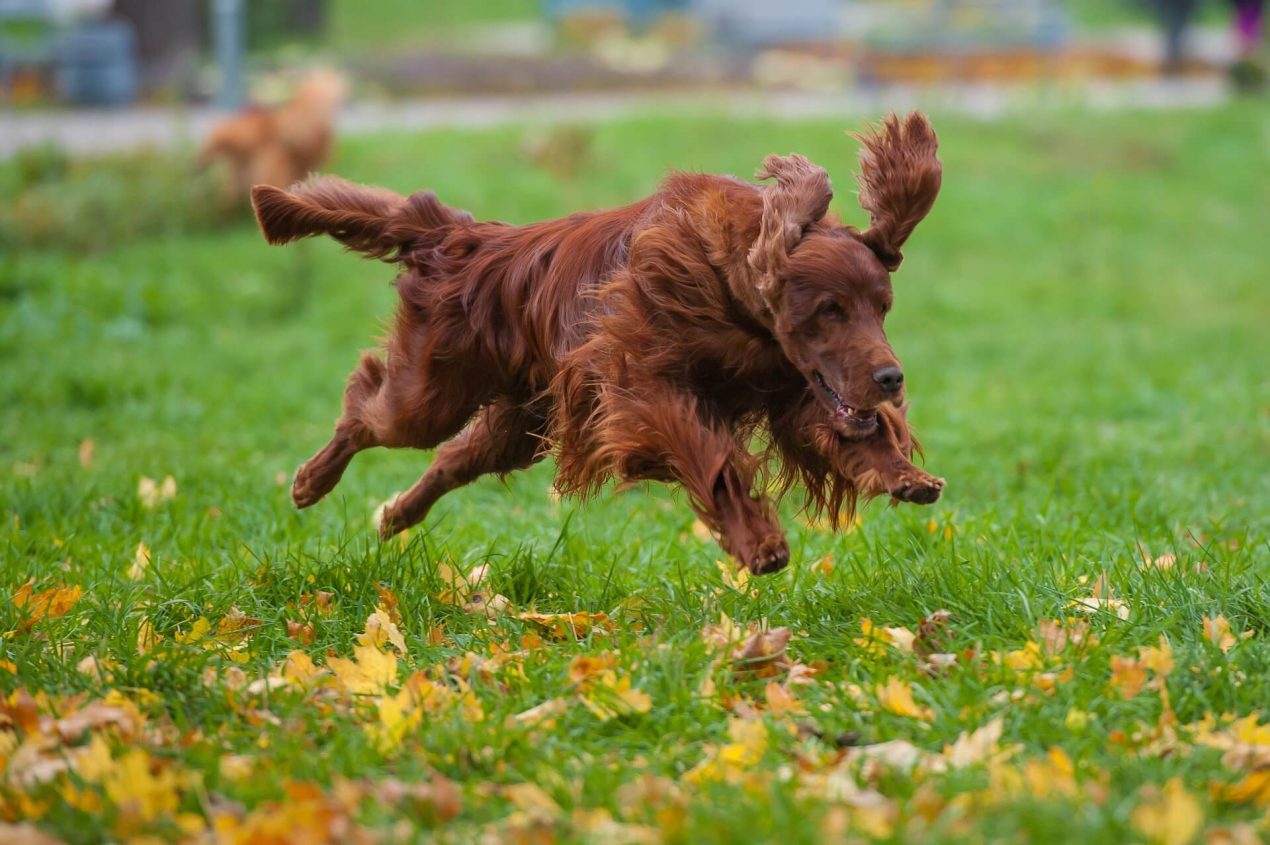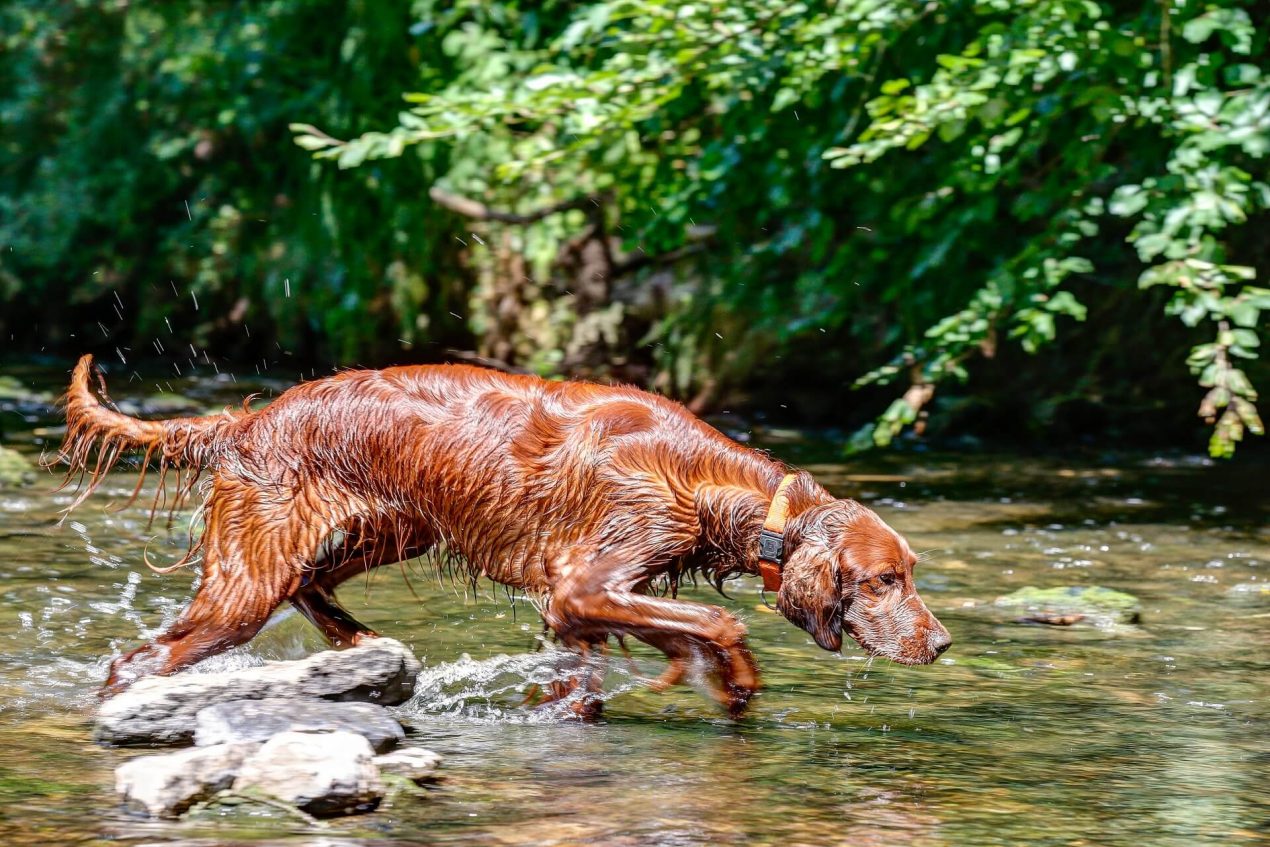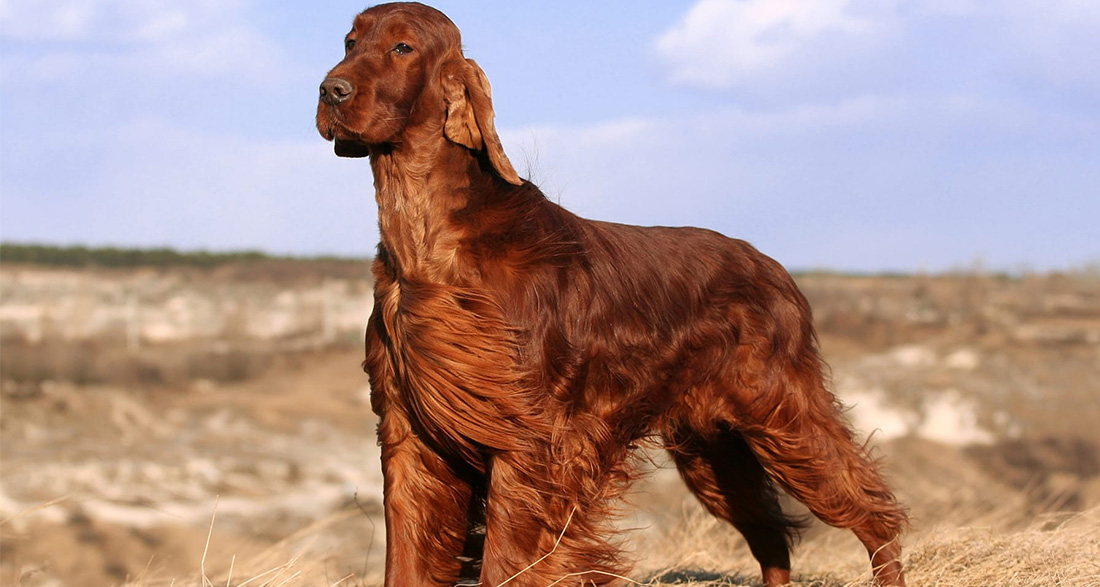The Irish Setter is an Irish dog breed officially known as the Irish Red Setter. This breed has been recognized by the AKC (American Kennel Club) and the FCI (Fédération Cynologique Internationale) under standard number 120, Group 7 – Pointing Dogs, Section 2 – British and Irish Pointers, 2.2 – Setters, with a working trial.
History and Origin
The Irish Setter is a hunting dog categorized as a pointing dog. Its origin involves the crossbreeding of Spaniels and Pointers, known as Setting Dogs, which were characterized by indicating game by lying down. In the 19th century, refinement and selection occurred, giving rise to the Gordon Setter, English Setter, Irish Red and White Setter, and the Irish Setter. Both red and red-and-white Setters were presented to the public in Dublin in 1874, collectively referred to as the Irish Setter.
The Ulster Irish Red Setter Club initially included both color variations in their breeding program in 1876, but by 1882, only the solid-colored variant was acknowledged. The Irish Red Setter Club established the breed standard in 1886. Renowned for its prowess in pointing and retrieving, the Irish Setter’s utility guidelines were published by the Irish Red Setter Club in 1998.
Breed Overview
GROUP: Sporting
HEIGHT: 25 to 27 inches
WEIGHT: 60 to 70 pounds
TEMPERAMENT: Affectionate, intelligent, athletic, gentle, sweet-tempered
COAT: Medium length with feathering on ears, chest, legs, and tail
COAT COLOR: Red, copper
HYPOALLERGENIC: No
LIFE SPAN: 12 to 15 years
Nature and Character
The character of the Irish Setter can be divided into two aspects. In the home, a well-exercised Setter is affectionate, loyal, and attached to its family. Due to its friendly nature, it gets along well with children. This sensitive companion requires close human contact and does poorly when left alone. On the other side, it is spirited and independent, requiring ample exercise and a purpose. Daily mental and physical stimulation is vital for its well-being. Intelligent and trainable, it adeptly handles given tasks.
| Affection Level | High |
| Friendliness | High |
| Kid-Friendly | High |
| Pet-Friendly | Medium |
| Exercise Needs | High |
| Playfulness | High |
| Energy Level | Medium |
| Trainability | High |
| Intelligence | High |
| Tendency to Bark | Low |
| Amount of Shedding | Medium |

Acquiring An Irish Setter
Before acquiring an Irish Setter, consider two essential questions:
- “Am I athletic enough?”
- “Do I have enough time?”
The arrival of a puppy will impact the next 14 years, demanding the commitment of the entire family. If you are both athletic and enamored with this breed but feel unsure about dog training, consider adopting an already trained adult Irish Setter from a shelter or rescue organization. An Irish Setter mix is also an option, though less common.
What to Consider When Purchasing
The purchase of an Irish Setter is a matter of trust. Information about reputable breeders can be obtained from the AKC (American Kennel Club). Online puppy listings are not necessarily negative, as serious breeders also utilize this medium for advertisements and maintaining a web presence. A conversation with the breeder allows you to quickly assess their credibility. The puppies should have received veterinary care (deworming, microchip, initial vaccinations), and the parent dogs should be free from hip dysplasia (HD) and adequately vaccinated.
A visit by potential owners is encouraged, allowing them to see the puppy’s environment, including the mother. Experienced breeders are interested not only in selling dogs but also in ensuring a suitable home. Expect to answer questions, and the puppies should not be rehomed before the age of 8 weeks, accompanied by all necessary documents, familiar food, and a personal blanket.
How Much Does It Cost?
The purchase price typically starts at around $1600 to $1800 and may vary upwards. Additionally, there is a distinction between the pure hunting line and the show line. Show breeding places more emphasis on appearance, potentially neglecting hunting instincts, although it does not eliminate them entirely.
Development and Training of the Puppy
Is the Irish Setter suitable for a novice owner?
Irish Setter puppies possess two characteristics that pose significant challenges for a novice dog owner: their inherent hunting passion and a considerable degree of independence. It is advisable to have some prior experience with dogs. This sensitive breed requires consistent training with a touch of empathy. With clear guidance (without harshness) and appropriate engagement, you can have a faithful companion. Building a bond from an early age is crucial, and seeking assistance from dog trainers, particularly those experienced with Setters, is recommended.

How to Care for an Irish Setter
A small city apartment is less suitable unless your Irish Setter is out and about with you for extended periods. A house with a garden is undoubtedly preferable. However, it’s essential to ensure that the garden fence is secure to prevent escapes, considering the considerable jumping ability, especially if there are cats in the neighborhood. This breed does not enjoy being alone, and while short periods are manageable with sufficient mental and physical stimulation, leaving this sensitive dog unattended for an entire workday is not advisable. Is an Irish Setter a family dog? For active families with older and more understanding children, the Irish Setter makes an excellent companion.
Activities with the Irish Setter
The Irish Setter, being a hunting dog with abundant energy and stamina, requires plenty of outdoor exercise. It makes an excellent jogging, cycling, and riding companion. Day hikes are easily manageable with this breed. Sporting dog owners should be mindful of their dog’s hunting instincts in open spaces. Using a suitable leash that doesn’t restrict activities but prevents “hunting excursions” is a wise precaution.

Various dog sports such as Mantrailing, Agility, Fetch, and Nose Work are also suitable for this breed. In all activities, it’s crucial to challenge both intelligence and physique.
Health and Grooming
The Irish Setter is a healthy and robust breed, assuming it comes from responsible breeding.
Despite its longer coat, grooming requirements are not high. Regular brushing is sufficient, with increased effort during shedding seasons. Additionally, regular checks of the ears, paws, and dog nails are necessary.
Interesting and Worth Knowing
The Irish Setter is a pointing dog, meaning it signals the presence of game to hunters through its body language. This physical indication is further emphasized by raising a front paw.
A variant of these pointing dogs is the Irish Red and White Setter, characterized by a white base color with red spots. This breed, a precursor to the Irish Red Setter, faced extinction and was stabilized through selective breeding in the mid-20th century.
A variant of the Irish Setter in black is the Gordon Setter.
The Irish Setter with short hair has minimal or no feathering.
Do you have an Irish Setter or are you considering getting one? Share in the comments what, in your opinion, makes this breed special!


